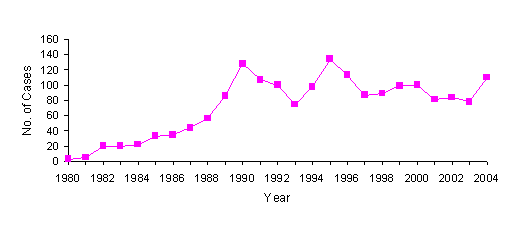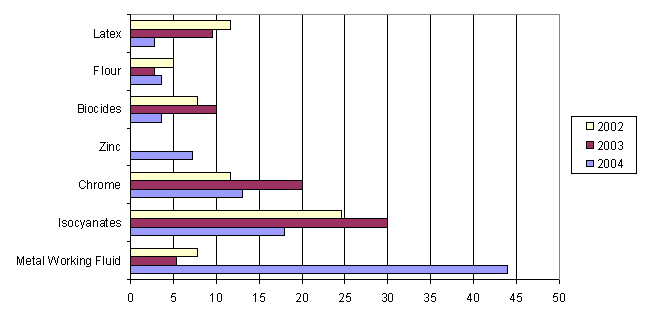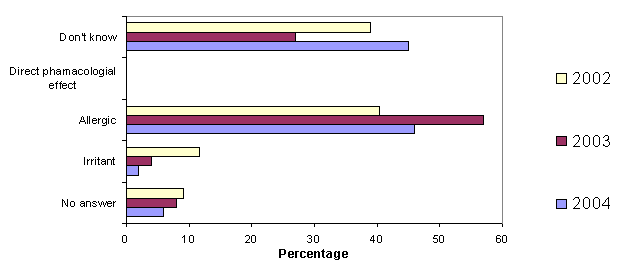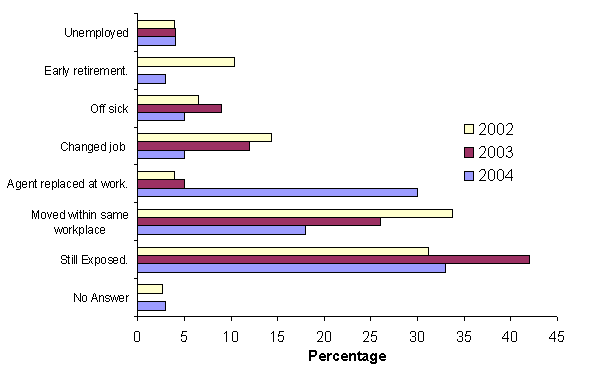Shield Report 2004; A Surveillance Scheme of Occupational Asthma in the Midlands |

|
C. Burge, V Huggins, AS Robertson, M Jaakkola and PS Burge.
Occupational Lung Disease Unit, Heartlands Hospital, Bordesley Green East, Birmingham B9 5SS.
SHIELD is the Midland Thoracic Society's Surveillance Scheme for Occupational Asthma for the West Midlands, in conjunction with the West Midlands group of the Society of Occupational Medicine. The scheme, which was set up in January 1989, was established to study the general and specific incidence of occupational asthma within the West Midlands region and Metropolitan County. There have been problems with the parent MTS rare disease reporting scheme this year due to data protection issues which has limited reports from outside the Birmingham Chest Clinic. Despite this the rate of reporting has shown little change over the last few years and has increased sharply this year, mainly due to a major outbreak. One hundred and ten reports have been received so far for 2004. The data protection issues have now been resolved and it is hoped that reports from others will be included next year.
The most common cause was Metal Working Fluid (48%) which were mostly from a single outbreak. Isocyanates came second (20%); they have been first for the last 12 years. It is likely that they remain the most common underlying cause of occupation asthma at present. Latex has continued to decline, both in percentage terms and numbers, suggesting that substitution of latex gloves is continuing. The outbreak of occupational asthma in a foundry where chrome fumes from stainless steel burning is the likely cause has continued since 2002 despite some remedial action, more were seen in 2004.
Ninety seven percent of cases reported in 2004 were by the Birmingham Chest Clinic and 3% by others. We hope to increase the number notified by others this year now that data protection issues have been resolved. The main database has identifiable patient data and needs consent from workers before entry. We are also happy to enter reports where no consent has been obtained; these will be entered without individual identification provided that the workplace is identified. This method is approved by our Caldicott guardian. Following a notification you will be told whether other (unnamed) workers have been identified from the same workplace, and suspected causes, to help remedial action (see the section on outbreaks below).
The most common method for the diagnosis of occupational asthma still remains a history of improvement of symptoms during holidays or periods off work. Some form of objective confirmation was made in 86% of patients.
We still have plans for web based reporting, but without some funding the plans remain on the shelf for the time being.
Introduction
Shield is a joint project between the West Midlands branch of the Society of Occupational Medicine and the Midland Thoracic Society. The scheme, which was set up in January 1989, was established to meet three main objectives. 1) To study the general and specific incidence of occupational asthma within a defined geographic area, 2) To determine proposed mechanisms of asthma, and 3) to audit diagnostic methods and objectives. Chest physicians and members of the West Midlands Group of the Society of Occupational Medicine implemented the scheme, by reporting each new case using a questionnaire format. The questionnaire covers confidential personal information on the patient, details of the diagnosis, information about their occupational history, and the outcome after diagnosis.
The last report on Shields progress was written in 2003 and summarised the information gained in that year, to that of previous years, 2002 and 2001. This report aims to update the participants of Shield by summarising the trends found in 2004 compared to those found in 2003 and 2002. The date used is the date of diagnosis rather than the date of reporting, resulting in some topping up of previous years reports and some underestimation of the current year.
Outbreak of the year
This year we discovered a major outbreak of occupational asthma at a company manufacturing car engines with over 800 employees which has skewed the underlying trends. There were no previous reports to Shield from this particular plant, although several previous reports have come from other car engine manufacturers. The clinical problem first came to light following identification of 12 workers from the same plant with extrinsic allergic alveolitis (hypersensitivity pneumonitis). Surveillance of the workforce has identified 7 further workers with probable allergic alveolitis, one with lipoid pneumonia and so far 47 reports of occupational asthma. A review of hospital and primary care notes has found four workers with peak flow records showing occupational asthma before the start of the Alveolitis. If these had been recognised and reported to Shield, there would have been an opportunity to prevent the outbreak of alveolitis. The precise cause of the outbreak is not yet established. There is exposure to aerosols from metal-working fluid (suds, coolant oil), and from water-based washers. Oil in air measurements are below the occupational exposure standards, and microbial contamination moderate.
Agent Awareness
The West Midlands is an area of major metal working and metal-working fluids have been a regular cause of occupational asthma since Shield began. In the past most cases have been due to inhalation of used oils, where microbial contamination is the most likely cause. In one plant cobalt (from stellite welding) dissolved in the coolant is the most common cause. Occasional cases are due to constituents of the unused oil, particularly colophony or tall oil products. We have also had a previous outbreak of alveolitis and asthma due to a contaminated water-based humidifier in a printing works, controlled by replacement with a steam humidifier (Thorax 1985;40: 248-254).
Figure 1 Number of cases diagnosed with metal working fluid as a possible cause since 1989![Figure 1: Number of cases diagnosed with metal working fluid as a possible cause since 1989.]()
Shield Data
Number of cases
The number of cases of occupational asthma reported to the Shield scheme for 2004 is 110 so far. When the SHIELD report for 2003 was written, there were 74 cases notified, but now this figure is up to 78 due to late reports. (The numbers pre 1989 are retrospective reports; reports are entered under the year of diagnosis rather than the year of reporting).
Figure 2 Number of cases diagnosed with occupational asthma between the years of 1980 and 2004 (cases pre 1989 retrospective reports)
Personal details
Of the 110 new cases reported in 2004 there were 92 males (84 %), and 14 females (13 %). 87 (79%) of the new cases had no pre-existing asthma, and 48 (44%) had never smoked.
Reporting Hospital and Physician
The Shield scheme is confined to the West midlands Region and the West Midlands Metropolitan County. In this region there are many chest physicians, hospitals, clinics and other organisations, which are known to the Shield scheme. In 2004, 107 (97 %) of the cases reported to Shield were through the Birmingham Chest Clinic, and 1 (1 %) through other organisations. We are hoping that there will be more cases reported from other institutions now that we have solved data protection issues.
Suspected agents at work
In 2004 the reported agents that the workers were exposed to is dominated by the outbreak and is metal-working fluid. The most common in 2003 and previous years (except 1997) was isocyanates, of which there were still 20 cases this year. This number of cases would have made isocyanates the most common cause in 2003. 382 cases of isocyanate suspected asthma have now been reported to the scheme, the first case being in 1978. 21 cases of isocyanate asthma were diagnosed in 2003 and 19 cases in 2002. Latex cases are continuing to decrease. Chrome cases continue to be high and are influenced by the 2002 / 2003 foundry outbreak, from which we are still seeing patients.
Common causative agents reported in 2004 were;
- Metal Working Fluid, 48 Cases (44%)
- Isocyanates, 20 Cases (18%)
- Chrome, 14 Cases (13%)
- Zinc, 8 Cases (7%)
- Flour, Biocides, Latex, Cobalt and others
Figure 3 Comparison of the percentage of patients exposed to the top ten agents in 2004 to those exposed in 2003 and 2002.

Employers and Jobs
There were 44 different employers reported to the scheme in 2004. 32 of these were new to the scheme. The major outbreak for 2004 currently accounts for 44% of all reports in 2004.
Around 60 different jobs were reported in 2004, although it would be possible to group some of the specific jobs into broader categories. The most common job was assembler at 12% of all notifications in 2004.
Table 1 A list of the most common agents reported in 2004 with the corresponding jobs
| Agent Exposed |
Job |
| Metal Working Fluid |
Turner, Tool Setter, Grinder, Assembler, Maintenance engineer, CNC operator, Electrician, Driller, Miller |
| Isocyanates |
Paint Sprayer, Chemist, Moulder, Core Maker, Printer, Production Engineer, Assembler |
| Chrome |
Welder, Arc Air Gouger, Powder Burner, Fettler, Crack Detector, Non destructive tester, Jigger |
| Zinc |
Zinc Welder, Engineer, Press setter, Inspector |
| Flour |
Baker, Sandwich maker |
| Biocides |
Assembler, Fitter |
| Latex |
Nurse, Health care worker, Custody Officer |
| Cobalt |
CNC Operator, Grinder |
Methods used for diagnosis
The methods used for the diagnosis that are documented on the shield form are; 1) Improvement on holiday, 2) Improvement off work, 3) Serial peak flow charts, 4) Specific IgE, 5) Methacholine at work, and 6) Methacholine away from work and 7) Specific bronchial provocation tests. 95 cases were documented as improving off work and on holidays. Of these, 86 cases had at least one other investigation. The most common investigation was serial peak flow charts (86 cases) followed by IgE (73 cases). There is currently 1 specific challenge performed on patients diagnosed in 2004. In 2003, there were 10 specific challenges performed.
Table 2 Percentage use of each method of diagnosing occupational asthma in 2004, 2003 and 2002.
| Method, |
% 2004, |
% 2003, |
% 2002 |
| Improving on holidays, |
92, |
95, |
92 |
| Improving off work, |
87, |
91, |
88 |
| Serial peak flow, |
78, |
84, |
64 |
| Specific IgE, |
66, |
51, |
46 |
| Methacholine at work, |
53, |
50, |
40 |
| Methacholine away from work, |
18, |
34, |
26 |
| Specific Bronchial Challenge, |
1 (so far), |
14, |
9 |
Proposed method of asthma
Figure 4 shows the proposed mechanism of asthma in workers with diagnosed occupational asthma in 2004, 2003 and 2002. In 2004 the most commonly reported mechanisms of asthma were allergic (46 %) and unknown (45%). In 2003 an allergic mechanism was also reported in most cases (60%). The percentage of the cases where the mechanism is not known is slightly more in 2004 compared to the previous year (28 %), but the percentage of 'no answer' has continued to decrease since 2002 and now stands at 6%. The other mechanisms (irritant and direct pharmacological effect) still remain very low in the percentage of proposed mechanisms.
Figure 4 Proposed mechanisms of asthma in 2004, 2003 and 2002

Subsequent History
The subsequent history of the workers diagnosed with occupational asthma in 2004 is broadly similar to that of 2003 and 2002. There are still many remaining exposed but the number off sick is continuing to go down. Moving within the workplace and replacing the agent are popular options and respiratory protection was seen extensively this year. The outbreak has a large influence on these figures, where the suspected agent has been controlled. This is probably less likely to happen where only one or two workers are having problems in a workplace. Relocation at work probably remains the most effective solution in most cases. The recorded subsequent history of the patient is taken at diagnosis and is subject to change so these figures will change with time. It is difficult to keep the database up to date so some of the changes will be missed. The report is usually made at the time of diagnosis and the employment situation is as of this time.
Figure 5 Subsequent history of patients diagnosed with occupational asthma in 2004, 2003 and 2002

Gold Standards
A gold standard occupational asthma case is defined by either; 1) Specific bronchial challenge test, 2) A four fold change in their non-specific bronchial reactivity with a good history, or 3) Positive IgE with a good history, and all of these can be accompanied by a good quality PEF record. 3% of cases have become gold standards in 2004 so far. This is lower than previous years but will improve as we receive more results. We have been unable to conduct bronchial challenges for the latter part of 2004 which has not helped.
Future Developments
We have solved the data protection issues and will now start to request notifications again from other institutions. We would like to add web based reporting to improve notification and updating but this is on hold for the time being due to resource constraints. There are organisational and technical changes to be made to improve accuracy and to help keep data up to date. We wish to combine the Shield database with the hospital Oasys peak flow database.
Conclusions
Occupational asthma remains a serious disease causing much morbidity, and is potentially preventable. The Health and Safety Executive are currently emphasising the need to control occupational asthma. Case detection is needed before control is likely. Shield provides the best method for linking cases seen by different clinicians. The database is confidential, has no legal standing or relation to compensation, and no personal details are ever released to others. The data protection act lead to a temporary suspension of reports from reporters outside the Birmingham Chest Clinic. This has resulted in a failed opportunity to prevent the largest outbreak of asthma and alveolitis that has occurred for many years.
Comments
Please sign in or register to add your thoughts.